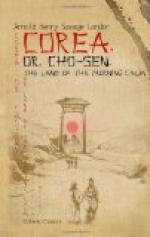[Illustration: A SINGER]
A few words must be added about that special class of women, the singers, who, as in Japan, are quite a distinct guild from the other women. A similar description to that of the geishas of Japan might apply to these gay and talented young ladies, who are much sought after by high officials and magistrates to enliven their dinner-parties with chanting and music. They are generally drawn from the very poorest classes, and good looks and a certain amount of wit and musical talent is what must be acquired to be a successful singer. They improvise or sing old national songs, which never fail to please the self-satisfied and well-fed official, and if well paid, they will even condescend to pour wine into their employer’s cups and pass sweets to the guests. If beautiful and accomplished, the “Corean artistes” make a very good living out of their profession, large sums of money being paid for their services. But if at all favoured by Nature, they generally end by becoming the unofficial wives of some rich minister or official. These women chalk their faces and paint their lips; they wear dresses made of the most expensive silks, and, like people generally who have sprung from nothing and find themselves lodged among higher folks than themselves, they give themselves airs, and cultivate a sickening conceit. Among the Coreans, however, they command and receive much admiration, and many an intrigue and scandal has been carried out, sometimes at the cost of many heads, through the mercenary turn of mind of these feminine musicians.
This music is to the average European ear more than diabolical, this being to a large extent due to the differences in the tones, semi-tones, and intervals of the scale, but personally, having got accustomed to their tunes, I rather like its weirdness and originality. When once it is understood it can be appreciated; but I must admit that the first time one hears a Corean concert, an inclination arises to murder the musicians and destroy their instruments. Of the latter they have many kinds, including string and brass, and drums, and cymbals, and other sorts of percussion instruments. The flutes probably are the weirdest of all their wind category, but the tone is pleasant and the airs played on them fascinating, although somewhat monotonous in the end, repetitions being continually effected. Then there is the harp with five strings, if I remember right, and the more complicated sort of lute with twenty-five strings, the kossiul; a large guitar, and a smaller one; the kanyako being also in frequent use. Most of these instruments are played by women; the flutes, however, are also played by men.
CHAPTER VI
Corean children—The family—Clans—Spongers—Hospitality—Spinning-tops —Toys—Kite-flying—Games—How babies are sent to sleep.




